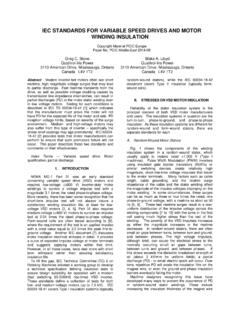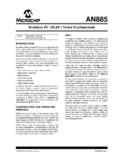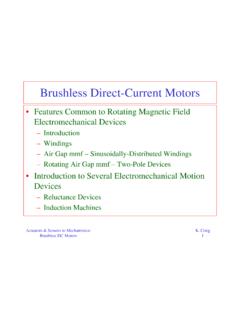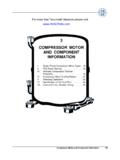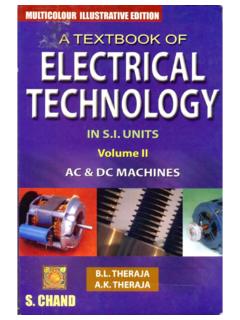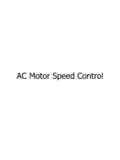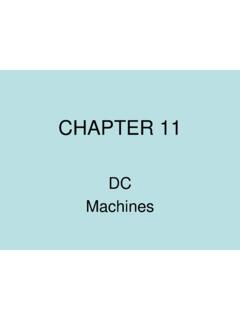Transcription of Electric Motor Problems & Diagnostic Techniques
1 Electric Motor Problems & Diagnostic Techniques3 Electric Motors Drive Today s FactoriesIn today s industry the workhorse that drives nearly all pumps, gearboxes, fans, etc. is the 3-phase AC Motor . Praised for its simplicity and durability, it often drives machinery 24/7, year after year. Although reliable, issues such as mounting Problems , lubrication failures, overloading and other issues can shorten service Electric Motor Problems are detected early, operational conditions can sometimes be altered to return the machines to an efficient state and prevent further damage: Rate of failure varies from one application to another.
2 Operators must understand failure modes and potential for failure for each machine. Criticality of application factors into how alarms are assigned. Important factors in the lifespan of the AC Motor : They must be cleaned regularly to prevent overheating. Insulation temperatures exceeding the Motor s rated value will cut the life of the insulation in half for every increase of 10 Problems EDM or FlutingFluting is caused by one of the following: Electromagnetic discharge (caused by the Motor ) Electrostatic discharge (belts, cylinders, etc.) External voltages (VFD, welding, etc.) Electric discharge can cause pitting in rolling elements as charges arc through the lubricant film from the rotating shaft to ground.
3 This pitting releases small fragments of material into the oil showing up as high particle counts, high ferrous density and wear debris. This promotes accelerated wear on bearings and other moving is a typical problem for large size motors (>200KW), VFD motors and vertical appearance of the washboard patter is very common. The difference between brinelling and fluting is that this pattern can be found all over the bearing (typically outer and inner race) while brinelling will typically manifest itself in the loaded LoadingBrinellingMounting ProblemsEDM or FlutingLubrication Problems4 Electric Motors Drive Today s FactoriesElectric DischargesEven small currents may have a big effect.
4 Electric discharge can be measured by checking the shat voltage and current amplitudes. The shaft voltage is often lower than (when greater than 3V, the appearance of the washboard pattern is very likely). More important is the amplitude of the current and if it is a fluctuating or spiking current, or a constant flowing effects of Electric discharge may be managed by grounding of the shaft or the use of ceramic : when insulating Motor bearings, other bearings driven by the Motor can fail due to Electric discharge. A grounding system is flow of current coming from the rotor to the stator can damage every bearing if countermeasures are not statordue to local heating of the windingStatorStatorRotorEccentric RotorConditionOKWarningAlarmFailureDiffe rence+ 54dB54 - 45 dB45 - 40 dB- 40 dBTesting for AC Motor FaultsPhase-to-ground faultDamaged or Contaminated InsulationTurn-to-turn, coil-to-coil.
5 And phase-to-phase faultsOpen phasesGround-Wall InsulationBroken/cracked rotor bars and rotor casting voidsStatic and dynamic rotor eccentricity and air gapPoor connectionsHarmonic distortionPhase ImbalanceFaulty capacitors in circuitPower condition, health, load and energy profileBearing faultsRotor shaft misalignmentMechanical ImbalanceDegraded or contaminated lubricantOil whip, Oil whirlStatorRotorPowerNon-ElectricMotor-c urrent analysisMotor-flux analysisVibration analysisOil analysisStep voltageSurge comparissonCapacitance-to-groundPolariza tion index (PI)Dielectric absorption (DA)Phase-to-phase resistancePhase-to-phase inductanceOnline power quality(HIPOT - AC or DC)High potential (megohmmeter)Resistance-t--groundxxxxxxx xxxxxxxxxxxxxxxxxxxxxxxxxxxIsolated BearingsGounding BrushesGrounding Color5 Abnormal LoadingAbnormal loading typically occurs when the dynamic load of the bearing is exceeded.
6 Any load greater than the design of the bearing will cause accelerated failure. Most ball or roller bearings (common in AC motors) are not good in handling large axial forces or severe misalignment conditions. A ball bearing has a limited range of dynamic load due to the small contact area. Several failure patterns exist, but in general there will be flaking of the surface where the load is inappropriate. BrinellingBrinelling typically occurs when there is a background vibration while the Motor is not running. This will cause the lubrication film to be pushed away, causing a cold-welding action between the roller and raceways.
7 The surface gets damaged and will result in progressive flaking. This can be avoided by isolating background vibrations and regularly switching the Motor with a backup Motor . Any static overload or severe impact (during mounting of a bearing) can also cause ProblemsImproperly mounted bearings may function well for a while but will eventually fail earlier than their design life. Improper fit of the Motor bearing can result in wear between the inner race and Motor shaft or the outer race and Motor housing. This is very detrimental to the Motor and can result in a much shorter lifetime or even catastrophic of sliding wear due to mounting Problems can occur on the inner and outer race.
8 Other patterns of improper fit are rusty markings on either or both of the inner and outer most cases vibration analysis will detect the abnormal looseness generated by this ProblemsIt is very important that the correct grease and the correct amount is used for each Motor . This is vital to prevent damage to the Motor bearings and other components. Too much or too little grease is a very common problem . In either case the Motor can be damaged by either popping the seals with too much, or running the bearing dry with no grease. Ultrasonic tools can help determine the correct amount of grease to apply.
9 BrinellingBrinelling typically occurs when there is a background vibration while the Motor is not running. This will cause the lubrication film to be pushed away, causing a cold-welding action between the roller and raceways. The surface gets damaged and will result in progressive flaking. This can be avoided by isolating background vibrations and regularly switching the Motor with a backup Motor . Any static overload or severe impact (during mounting of a bearing) can also cause BearingsMost large AC motors are equipped with sleeve bearings. Although very reliable, some specific Problems can exist.
10 The most common problem is direct contact between the rotor shaft and sleeve bearing, causing abnormal vibration, oil discoloration and melted Babbit metal particles in lubricating oil. Causes for this type of damage include: Abnormal loading Incorrect lubricant or sudden changes in viscosity Severe misalignmentVibration and oil analysis are the main technologies to assess the condition of the Motor s sleeve bearing has a well-defined colored raceway. The inner race is still intact but the effect of high heat can clearly be seen. These elevated temperature are typically caused by the bearing running with boundary lubrication or with no being in service for a short time, elevated noise levels were detected.











